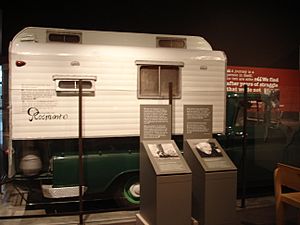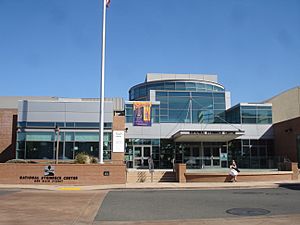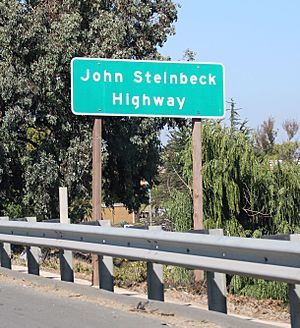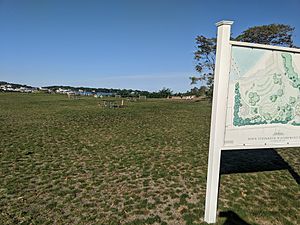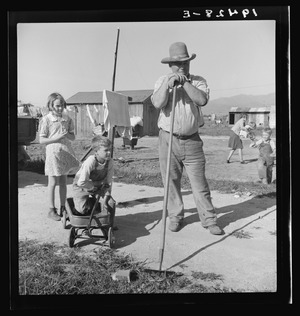John Steinbeck facts for kids
Quick facts for kids
John Steinbeck
|
|
|---|---|
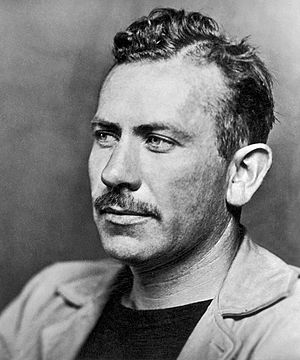
Steinbeck in 1939
|
|
| Born | John Ernst Steinbeck Jr. February 27, 1902 Salinas, California, U.S. |
| Died | December 20, 1968 (aged 66) New York City, U.S. |
| Occupation |
|
| Notable works |
|
| Notable awards |
|
| Spouses |
Carol Henning
(m. 1930; div. 1943)Gwyn Conger
(m. 1943; div. 1948)Elaine Scott
(m. 1950) |
| Signature | |
John Ernst Steinbeck Jr. (born February 27, 1902 – died December 20, 1968) was a famous American writer. He won the 1962 Nobel Prize in Literature for his "realistic and imaginative writings." People often called him "a giant of American letters."
During his life, he wrote 33 books. These included 16 novels and many short stories. He is well-known for funny novels like Tortilla Flat (1935) and Cannery Row (1945). He also wrote the long family story East of Eden (1952). His shorter novels, The Red Pony (1933) and Of Mice and Men (1937), are also very popular.
His book The Grapes of Wrath (1939) won the Pulitzer Prize. Many people think it is his best work. It sold 14 million copies in its first 75 years. Most of Steinbeck's stories take place in central California. He often wrote about ordinary people facing unfair situations.
Contents
Early Life and Education
John Steinbeck was born in Salinas, California, on February 27, 1902. His family had German, English, and Irish roots. His father, John Ernst Steinbeck, was a treasurer for Monterey County. His mother, Olive Hamilton, was a teacher who loved reading and writing. She shared this passion with young John.
Steinbeck grew up in a small valley near the Pacific Coast. This area became the setting for many of his stories. In the summers, he worked on ranches. He also worked with migrant workers on sugar beet farms. There, he saw the hard lives of these workers. This experience gave him ideas for books like Of Mice and Men.
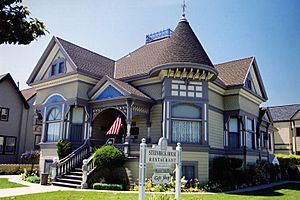
He finished high school in Salinas in 1919. Then, he studied English literature at Stanford University. He left college in 1925 without a degree. He moved to New York City and tried to become a writer. When his writing wasn't published, he returned to California.
In 1928, he worked as a tour guide at Lake Tahoe. There, he met Carol Henning, who became his first wife. They married in 1930. They moved to Pacific Grove, California, where his father owned a cottage. His parents helped him by giving him free housing and paper for his stories. During the Great Depression, Steinbeck and Carol sometimes struggled for money. They shared whatever food they had with friends.
In 1930, Steinbeck met Ed Ricketts, a marine biologist. Ricketts became a close friend and helped Steinbeck learn about philosophy and biology. Ricketts believed that humans are just one part of a huge web of life. This idea influenced Steinbeck's writing. Ricketts also ran a lab that sold sea creatures to schools. Steinbeck's wife worked there, and John often helped out.
Writing Career
First Novels and Early Success
Steinbeck's first novel, Cup of Gold, came out in 1929. It was about the pirate Henry Morgan. Between 1930 and 1933, he wrote three shorter books. The Pastures of Heaven (1932) was a collection of stories about a valley near Monterey. The Red Pony (1933) was a story based on his childhood memories.
Steinbeck became well-known with Tortilla Flat (1935). This funny novel is about a group of homeless young men in Monterey after World War I. It won a gold medal for literature. The book was made into a movie in 1942. With the money he earned, Steinbeck built a summer home.
Stories of the Great Depression
Steinbeck then started writing novels about common people during the Great Depression. These included In Dubious Battle, Of Mice and Men, and The Grapes of Wrath. He also wrote newspaper articles about the hard lives of migrant workers.
Of Mice and Men was a play and a novel about two farm workers, George and Lennie. It was praised by critics and called a "little masterpiece." The play was very popular. It was also made into a Hollywood film in 1939 and again in 1992.
His most famous book, The Grapes of Wrath (1939), was based on his articles about migrant workers. It became a bestseller and won the Pulitzer Prize for Fiction. The book was made into a film by John Ford. However, the book was also controversial. Some people in California banned it because it showed the harsh realities of capitalism and supported workers.
Friendship with Ed Ricketts
Ed Ricketts greatly influenced Steinbeck's writing in the 1930s and 1940s. They often took trips together to collect sea creatures. In 1941, they wrote a book together called Sea of Cortez. Later, Steinbeck republished part of it as The Log from the Sea of Cortez under his name.
Ricketts was the inspiration for the character "Doc" in Steinbeck's novels Cannery Row (1945) and Sweet Thursday (1954). Steinbeck's close friendship with Ricketts ended when Steinbeck moved away and divorced his first wife. Ricketts died in 1948, which deeply affected Steinbeck.
Later Works and World War II
Steinbeck's novel The Moon Is Down (1942) was about people resisting occupation in a European village during World War II. It was quickly made into a film. In 1945, he received an award from Norway for his support of their resistance movement.
During World War II, Steinbeck worked as a war correspondent for a newspaper. He reported from the battlefield and even joined some commando raids. He wrote about these experiences in Once There Was a War (1958).
After the war, he wrote Cannery Row (1945). This book became so famous that the street it was set on in Monterey was renamed Cannery Row. He also wrote The Pearl (1947), a story he heard in Mexico. He later wrote the film script for Viva Zapata! (1952), about a Mexican revolutionary.
In 1947, Steinbeck visited the Soviet Union with photographer Robert Capa. He wrote about their trip in A Russian Journal (1948).
In 1952, his longest novel, East of Eden, was published. He considered it his most important work. Parts of it were made into a movie in 1955, starring James Dean.
In 1960, Steinbeck took a long road trip across the United States with his poodle Charley. He wrote about this journey in Travels with Charley: In Search of America. He called his truck Rocinante, like Don Quixote's horse. His last novel, The Winter of Our Discontent (1961), looked at moral issues in America.
Nobel Prize
In 1962, John Steinbeck won the Nobel Prize in Literature. The award was for his "realistic and imaginative writing." Some critics in America thought he didn't deserve it. When asked if he thought he deserved the prize, Steinbeck simply said, "Frankly, no."
However, the Nobel committee chose him for his unique way of telling stories. They felt he truly captured what it meant to be American. In 1964, President Lyndon B. Johnson gave Steinbeck the Presidential Medal of Freedom.
In 1967, Steinbeck went to Vietnam to report on the Vietnam War. He supported the American soldiers there. His sons also served in Vietnam, and he visited one of them on the battlefield.
Personal Life
John Steinbeck was married three times. His first marriage was to Carol Henning in 1930. They divorced in 1941. In 1942, he married Gwyndolyn "Gwyn" Conger. They had two sons, Thomas and John Steinbeck IV. This marriage ended in 1948.
In 1950, Steinbeck married Elaine Scott. This marriage lasted until his death in 1968. He was also friends with the poet Robinson Jeffers. Steinbeck was a mentor to young writer Jack Rudloe.
Death and Legacy
John Steinbeck died in New York City on December 20, 1968. He was 66 years old and had heart disease. He was a lifelong smoker. His body was cremated, and his ashes were buried in Salinas, California. He rests with his parents and grandparents.
Many of Steinbeck's books are still read in high schools today. Of Mice and Men is a very popular book in schools in the United States and the United Kingdom. However, some of his books, like The Grapes of Wrath, have been banned at times. This happened because they showed difficult social issues or used strong language.
Literary Influences
Steinbeck grew up in California's Salinas Valley. This area had many different cultures and people. This background gave his writing a special "sense of place." Salinas, Monterey, and the San Joaquin Valley were often the settings for his stories. This area is now called "Steinbeck Country."
He often wrote about working-class people and migrant workers. His stories showed their struggles during the Dust Bowl and the Great Depression. Later in his life, his interests grew to include marine biology, politics, and history.
Commemoration
Steinbeck's childhood home in Salinas has been saved and restored. You can visit it for lunch and tours. The National Steinbeck Center in Salinas is a museum dedicated to him. It has "Rocinante," the camper truck from Travels with Charley.
In Monterey, you can still see Ed Ricketts's lab and the area Steinbeck described in Cannery Row. In 1958, Ocean View Avenue was renamed Cannery Row to honor his book.
In 1979, the United States Postal Service put Steinbeck on a postage stamp. In 2007, he was inducted into the California Hall of Fame. In 2014, Google created an interactive doodle to celebrate his birthday. A part of U.S. Route 101 in Salinas is now called the John Steinbeck Highway.
In 2019, a park in Sag Harbor, New York, was named the John Steinbeck Waterfront Park.
Religious and Political Views
Steinbeck was part of the Episcopal Church throughout his life. His stories often used ideas and language from the Bible. He explored themes of good and evil, and how people change.
Steinbeck was interested in leftist ideas and workers' rights. He joined the League of American Writers, a group with Communist ties. He also supported Arthur Miller when Miller faced challenges during the House Un-American Activities Committee trials. Steinbeck called that time "one of the strangest and most frightening times."
His views on the Vietnam War were different from some of his earlier political stances. He supported the American military in Vietnam.
Major Works
In Dubious Battle
Published in 1936, this was the first book in his "Dustbowl trilogy." It tells the story of a fruit pickers' strike in California. The strike gets help from a group called "the Party," which is thought to be the Communist Party.
Of Mice and Men
This sad story was written as a play and a novel in 1937. It's about two traveling farm workers, George and Lennie. They dream of owning their own farm. The story shows what life was like during the Great Depression. It also explores themes like racism, loneliness, and how people treat those with mental disabilities. It has been made into a movie three times.
The Grapes of Wrath
Set during the Great Depression, this book follows the Joad family. They are sharecroppers who lose their farm because of the Dust Bowl dust storms. They travel to California looking for work. The book won the National Book Award and the Pulitzer Prize. It was also made into a movie.
East of Eden
This long novel, published in 1952, explores the ideas of good and evil. It follows two families, the Hamiltons (based on Steinbeck's own family) and the Trasks. The story reminds readers of the Biblical story of Adam and his sons. Parts of the novel were made into a movie in 1955.
Travels with Charley
In 1960, Steinbeck bought a pickup truck with a special camper top. He drove across the United States with his poodle, Charley. He called his truck Rocinante. In this book, Steinbeck describes what he saw and felt during his trip. The restored camper truck is now on display at the National Steinbeck Center.
Film Adaptations
Many of John Steinbeck's books have been made into movies:
- 1939: Of Mice and Men
- 1940: The Grapes of Wrath
- 1942: Tortilla Flat
- 1943: The Moon is Down
- 1944: Lifeboat (directed by Alfred Hitchcock)
- 1947: The Pearl (Mexico)
- 1949: The Red Pony
- 1952: Viva Zapata!
- 1955: East of Eden (starring James Dean)
- 1982: Cannery Row
- 1992: Of Mice and Men
- 2016: In Dubious Battle
See also
 In Spanish: John Steinbeck para niños
In Spanish: John Steinbeck para niños


